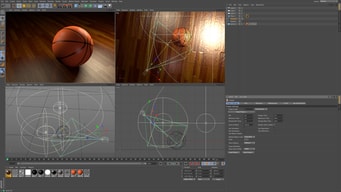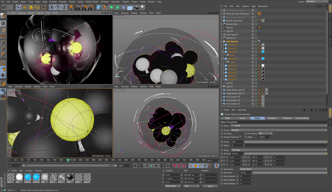

Unclaimed: Are are working at Cinema 4D ?
Cinema 4D Reviews & Product Details
Cinema 4D is a platform for 3D modeling, animation, and rendering often used by graphic designers, game developers, as well as motion graphics artists. Top features include polygon modeling, particle effects, character animation, and advanced lighting tools that allow designers to create high-quality 3D content for different industries.

| Segment |
|
|---|---|
| Deployment | Cloud / SaaS / Web-Based, Desktop Mac, Desktop Windows |
| Training | Documentation |
| Languages | English |






xPresso and Mograph would be no doubt my two favorite features in Cinema4D. With a few simple steps you can build really complex and cool graphics with a tremendous amount of control. The tight integration of Mograph with all C4D tools are what makes it the greatest software for Motion Design to date. There is no equal in the field.The learning curve is small and any Designer can get up to speed with it within a few days.
The thing that upsets me the most is the particle system. Would be really lovely if Maxon acquire X-Particle! The dynamic system is too unpredictable at times and there is no nodal environment for shading out of the box.
Motion Design and Virtual Photography.
Can create brilliant assets for implementing inside motion graphics, AR in particular
Very complicated at times, and a severe lack of online courses or tutorials
3D designs for animations
The simplicity of the software and the efficiency and the quality of graphics we can create out of it. The tools like Mograph is impressive and the integration with After effects is awesome.
The Redshift is too costly. The bundle of Maxon One is very costly, though it has many plugins. There is no proper trial version too. Only disadvantage I see is the support for Redshift and no other renderers.
CInema 4D produces faster results. Always a great tool for shorter deadlines. We can achieve great outputs using the mograph tools. The possibilities are endless.
User-Friendly, it's been used by a lot of successful companies.
Rendering, It would take some time to render detailed objects.
Product Development, it shows how the structural, skeletal view and gives more idea of how it works.
As a power user of this software since R15 - this is hands down the best software package for all things motion graphics, to creating and preparing lightweight solid & organic models for interactive / AR / VR experiences. Along with valuable software integrations and plugins, C4D will be the best tool for an agile visual graphics workflow.
What I dislike the most about C4D is how Maxon has changed their pricing to a subscription model as of 2019(?) for new releases - it doesn't impact my day to day work too much, but I miss the days when perpetual licenses were a thing.
C4D is my daily driver when it comes to all things 3D, be it for traditional motion graphics workflows - or using the amazing hard surface / organic modeling features to create models that can be exported into other software like Unity, Unreal Engine, or into other 3D programs like VRED or Maya. C4D is my trusty hammer, and I wouldn't switch to anything else.
I like the options it has, the tools allow the user to make complex modeling, animate, and render with the best results without having to use an additional software if prefered
The interface might not be easy to understand for a beginner in 3D modeling, and the way the layout is set, might make it a little bit complicated when first starting with the program. Also, the mouse shortcuts are different from the rest of the 3D software, it would be nice if they were standarized
i can model my design before actually producing in real life, making me realize mistakes or ways to improve a design beforehand, it also helps me to visualize the final result of something
The tools in Cinema 4D can be used for a wide range of 3D applications. Users of the program can create basic to complex models quickly, regardless of their experience level. This program not only simplifies modeling, but also adds lighting, textures, and animation. If you would like to create a photorealistic image or a cartoon, this program can help.
In spite of decades on the market, there is still a lack of training material for this software. As a program, C4D is capable of so many things and has many bells and whistles. We need tutorials that cover every aspect of the program.
The range of projects we work on using Cinema 4D includes illustration, video, and animation. There is a large asset library included with Maxon that can be compiled for rapid development of sets, scenes, and effects.
The integrated renderer in cinema 4d is both fast and effective. The learning resources are vast and you can learn simple techniques and also complex things like VFX in both a fun and professional way.
The software is a bit pricey for beginner designers. Without proper guidance, the interface is overwhelming to users. Users most of the time use only 10% of the tools to get their designs done, the other 90% of tools are unknown and useless to some users.
I use Cinema 4d to design some basic models like Solar panels, Wind turbines, and sometimes architectural materials for my company projects and also for my personal projects. I am learning more about this software day by day.
Cinema 4D has impressive tools, especially for animation. But what first caught me was the clean and visually comfortable work environment. You can spend hours working on your 3d project without getting tired, inside Cinema 4D it's a pleasant activity.
The modeling tools are good enough but they can improve, especially retopology. If you need a quick and automated solution to retopology your model, it can be complicated with the tools available in Cinema 4D alone.
I feel comfortable in Cinema 4D from the first day of use, its intuitive interface makes the tools easy to access and provides a smooth workflow. I create animations daily where it requires several hours of work, and it doesn't make me tired.
Things that I like about Cinema 4D are 1. It is straightforward to learn 2. The viewport can be configured according to other applications like 3Ds Max 3. The tools are modeling friendly 4. It is very well equipped and loaded with most of the tools and features for 3d graphics 5. Easy to export files to other formats 6. It has a built-in render farm (team Render) 7. It is super stabl
1. It is super expensive 2. Bodypainting and UV Texture editing needs to improve 3. Render output is not as good as other Softwares 4. It crashes in heavy scenes 5. Not suitable for developing interactive animation
Cinema 4D is a very easy yet advanced 3D Modeling and simulation application. However, it is very useful in 3d modeling but has a few problems when it comes to pricing the software, texturing UVs, animations, and rigging the model. It is hard to integrate with games.